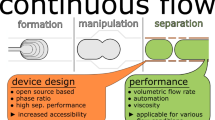Abstract
The preparation of double emulsion droplet is a significant development direction in droplet microfluidics. In this paper, we simulate the droplet formation inside a six-way type microchannel. The effects of flow rate, viscosity, and interfacial tension of microfluid on the process of droplets preparation are investigated, i.e., the forming quality of droplets under different flow parameters and physical properties of microfluid, which is of reference significance for the preparation of microdroplets such as double emulsion droplet. In this paper, it is found that when the flow rate of the outer phase increases, the area of the inner and outer droplets of double emulsion droplets decreases; when the flow rate of the middle phase increases, the area of the inner droplet decreases, while the area of the outer droplet increases; the viscosity affects the forming flow pattern, and the location where the area ratio of inner and outer droplets changes more intensely is near the flow pattern transition node; the interfacial tension has a significant influence on the forming size of droplets.


















Similar content being viewed by others
References
Whitesides GM (2006) The origins and the future of microfluidics. Nature 442(7101):368–373. https://doi.org/10.1038/nature05058
Yager P et al (2006) Microfluidic diagnostic technologies for global public health. Nature 442(7101):412–418. https://doi.org/10.1038/nature05064
Jurinjak Tušek A et al (2021) The power of microsystem technology in the food industry: going small makes it better. Innov Food Sci Emerg Technol 68:102613. https://doi.org/10.1016/j.ifset.2021.102613
McIlroy DA, Blaiszik BJ, Caruso MM, White SR, Moore JS, Sottos NR (2010) Microencapsulation of a reactive liquid-phase amine for self-healing epoxy composites. Macromolecules 43(4):1855–1859. https://doi.org/10.1021/ma902251n
Atencia J, Beebe DJ (2005) Controlled microfluidic interfaces. Nature 437(7059):648–655. https://doi.org/10.1038/nature04163
Shah RK et al (2008) Designer emulsions using microfluidics. Mater Today 11(4):18–27. https://doi.org/10.1016/S1369-7021(08)70053-1
Utada AS, Lorenceau E, Link DR, Kaplan PD, Stone HA, Weitz DA (2005) Monodisperse double emulsions generated from a microcapillary device. Science 308(5721):537–541. https://doi.org/10.1126/science.1109164
Chu L-Y, Utada AS, Shah RK, Kim J-W, Weitz DA (2007) Controllable monodisperse multiple emulsions. Angew Chem Int Ed 46(47):8970–8974. https://doi.org/10.1002/anie.200701358
He P, Barthès-Biesel D, Leclerc E (2010) Flow of two immiscible liquids with low viscosity in Y shaped microfluidic systems: effect of geometry. Microfluid Nanofluid 9(2–3):293–301. https://doi.org/10.1007/s10404-009-0546-y
Christopher GF, Noharuddin NN, Taylor JA, Anna SL (2008) Experimental observations of the squeezing-to-drip** transition in T-shaped microfluidic junctions. Phys Rev E 78(3):036317. https://doi.org/10.1103/PhysRevE.78.036317
Abate AR, Weitz DA (2009) High-order multiple emulsions formed in poly(dimethylsiloxane) microfluidics. Small 5(18):2030–2032. https://doi.org/10.1002/smll.200900569
Abate AR, Thiele J, Weitz DA (2011) One-step formation of multiple emulsions in microfluidics. Lab Chip 11(2):253–258. https://doi.org/10.1039/C0LC00236D
Azarmanesh M, Farhadi M, Azizian P (2016) Double emulsion formation through hierarchical flow-focusing microchannel. Phys Fluids 28(3):032005. https://doi.org/10.1063/1.4944058
Askari AH, Shams M, Sullivan PE (2019) Numerical simulation of double emulsion formation in cross-junctional flow-focusing microfluidic device using Lattice Boltzmann method. J Dispers Sci Technol 40(10):1451–1460. https://doi.org/10.1080/01932691.2018.1518141
Okushima S, Nisisako T, Torii T, Higuchi T (2004) Controlled production of monodisperse double emulsions by two-step droplet breakup in microfluidic devices. Langmuir 20(23):9905–9908. https://doi.org/10.1021/la0480336
Azarmanesh M, Farhadi M, Azizian P (2015) Simulation of the double emulsion formation through a hierarchical T-junction microchannel. Int J Numer Methods Heat Fluid Flow 25(7):1705–1717. https://doi.org/10.1108/HFF-09-2014-0294
Nurumbetov G, Ballard N, Bon SAF (2012) A simple microfluidic device for fabrication of double emulsion droplets and polymer microcapsules. Polym Chem 3(4):1043. https://doi.org/10.1039/c2py00605g
Xu J-H, Ge X-H, Chen R, Luo G-S (2014) Microfluidic preparation and structure evolution of double emulsions with two-phase cores. RSC Adv 4(4):1900–1906. https://doi.org/10.1039/C3RA46562D
Lei L, Zhang H, Bergstrom DJ, Anthony T, Song K-Y, Zhang W (2020) Experimental and simulation study of flow patterns in the combined flow focusing and T-junction device. J Micromech Microeng 30(5):055001. https://doi.org/10.1088/1361-6439/ab7787
Deshpande S, Caspi Y, Meijering AEC, Dekker C (2016) Octanol-assisted liposome assembly on chip. Nat Commun 7(1):10447. https://doi.org/10.1038/ncomms10447
Schaich M, Sobota D, Sleath H, Cama J, Keyser UF (2020) Characterization of lipid composition and diffusivity in OLA generated vesicles. Biochim Biophys Acta BBA: Biomembr 1862(9):183359. https://doi.org/10.1016/j.bbamem.2020.183359
Tan S, Gao C, Liu H, Ye B, Sun D (2020) Research of double emulsion formation and shell-thickness influence factors in a novel six-way junction microfluidic device. Colloids Surf Physicochem Eng Asp 601:124917. https://doi.org/10.1016/j.colsurfa.2020.124917
Jiang F et al (2019) Numerical study on the effect of temperature on droplet formation inside the microfluidic chip. J Appl Fluid Mech 12(3):831–843. https://doi.org/10.29252/jafm.12.03.29506
ANSYS, Inc., ANSYS fluent theory guide. 2021
Roux E, Bougaran P, Dufourcq P, Couffinhal T (2020) Fluid shear stress sensing by the endothelial layer. Front Physiol 11:861. https://doi.org/10.3389/fphys.2020.00861
Gueyffier D, Li J, Nadim A, Scardovelli R, Zaleski S (1999) Volume-of-fluid interface tracking with smoothed surface stress methods for three-dimensional flows. J Comput Phys 152(2):423–456. https://doi.org/10.1006/jcph.1998.6168
Acknowledgements
This research is supported by the Science and Technology Plan of Guangzhou City (Grant Nos. 202102010386, 202201020226), NSFC (Grant No. 51975135).
Author information
Authors and Affiliations
Corresponding author
Ethics declarations
Conflict of interest
The authors declare that they have no known competing financial interests or personal relationships that could have appeared to influence the work reported in this paper.
Additional information
Publisher's Note
Springer Nature remains neutral with regard to jurisdictional claims in published maps and institutional affiliations.
Rights and permissions
Springer Nature or its licensor (e.g. a society or other partner) holds exclusive rights to this article under a publishing agreement with the author(s) or other rightsholder(s); author self-archiving of the accepted manuscript version of this article is solely governed by the terms of such publishing agreement and applicable law.
About this article
Cite this article
**e, B., Jiang, F., Lin, H. et al. Numerical investigation of the effect of microfluidic flow parameters and physical properties on double emulsion droplet forming. Meccanica 59, 157–168 (2024). https://doi.org/10.1007/s11012-023-01723-9
Received:
Accepted:
Published:
Issue Date:
DOI: https://doi.org/10.1007/s11012-023-01723-9




